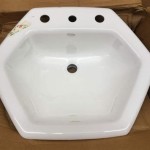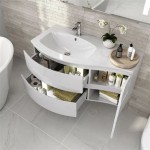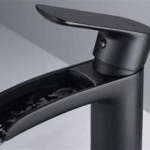Are Tiles Necessary In A Bathroom?
The question of whether tiles are strictly necessary in a bathroom environment is a multifaceted one. Historically, tiles have been the dominant material choice for bathroom surfaces, particularly floors and walls, due to their perceived durability and water resistance. However, with advancements in building materials and waterproofing technologies, alternative options have emerged, prompting a reassessment of the necessity of tile in modern bathroom design. This article will explore the conventional benefits of tile, discuss viable alternative materials, and analyze the critical factors influencing the decision to use or forego tile in a bathroom.
Traditionally, bathrooms have presented significant challenges in terms of moisture management. The presence of standing water from showers and baths, coupled with high humidity levels, creates an environment conducive to mold growth, material degradation, and potential structural damage. Tiles, particularly ceramic and porcelain varieties, have been favored for their inherent resistance to water absorption. Their hard, non-porous surface effectively repels water, preventing it from penetrating the substrate and causing problems beneath. The grout lines between tiles, while potentially problematic if improperly sealed, are minimized with advancements such as epoxy grout, which offers improved water resistance and durability.
Beyond their moisture resistance, tiles are also prized for their durability and ease of maintenance. They can withstand heavy foot traffic, resist staining, and are relatively simple to clean. A regular wipe-down with a mild detergent is typically sufficient to maintain their appearance. Further, the inherent hardness of tile provides a robust surface that resists scratches and dents, contributing to its long-term lifespan. This longevity makes tile a cost-effective choice over time, despite the initial investment in materials and installation.
The Core Benefits of Tile in Bathrooms
The widespread use of tile in bathrooms stems from several key advantages that have historically made it the go-to material. These benefits provide a strong argument for its continued relevance in bathroom design. Understanding these core benefits is crucial to evaluating the necessity of tile and determining whether alternative materials can adequately address the specific demands of a bathroom environment.
First and foremost is
water resistance
. As mentioned previously, the primary function of any bathroom surface is to prevent water damage. Tile, especially porcelain and ceramic, boasts an exceptionally low water absorption rate. This characteristic prevents water from seeping into the underlying structure, safeguarding against mold growth, wood rot, and structural degradation. The surface of the tile itself is impervious to water, and with proper grout selection and sealing, the entire tiled surface acts as a reliable moisture barrier.Secondly,
durability
is a significant factor. Bathrooms are high-traffic areas, particularly in homes with multiple occupants. The floor must withstand constant use, and the walls are subject to splashes, impacts, and general wear and tear. Tile is known for its strength and resistance to damage. It can endure heavy loads, resist scratches, and maintain its appearance for many years with minimal maintenance. This durability translates to a long lifespan and reduces the need for frequent replacements, making tile a cost-effective option in the long run.Finally,
ease of cleaning and maintenance
contributes significantly to the appeal of tile. The smooth, non-porous surface of tile makes it simple to wipe clean and resistant to stains. Unlike some other materials, tile does not require special cleaning products or extensive maintenance routines. A regular cleaning with a mild detergent is typically all that is needed to keep tile looking its best. This low-maintenance aspect is particularly attractive to homeowners seeking a practical and hassle-free bathroom surface.Alternative Materials for Bathroom Surfaces
While tile has traditionally been the dominant choice, a variety of alternative materials offer compelling options for bathroom surfaces. These alternatives often provide different aesthetic qualities, cost considerations, and installation complexities. A thorough understanding of these materials and their limitations is essential for making an informed decision about the necessity of tile in a particular bathroom design.
One increasingly popular alternative is
waterproof vinyl flooring
. Luxury vinyl planks (LVP) and sheets are specifically engineered to withstand moisture and are available in a wide range of styles and patterns, mimicking the appearance of wood, stone, and even tile. Modern vinyl flooring offers excellent durability, ease of installation, and a softer, warmer feel underfoot compared to tile. However, it is crucial to choose a product specifically designed for wet environments to ensure long-term performance and prevent water damage.Epoxy flooring
presents another robust and seamless option. Epoxy is a thermosetting polymer that creates a durable, waterproof surface. It can be applied directly to the subfloor, eliminating grout lines and creating a hygienic, easy-to-clean surface. Epoxy flooring is highly customizable in terms of color and design, allowing for a wide range of aesthetic possibilities. While epoxy offers excellent performance characteristics, professional installation is typically required to ensure proper application and a long-lasting finish.Waterproof wall panels
offer an alternative to tiling bathroom walls. These panels, often made of PVC or acrylic, are designed to interlock and create a seamless, waterproof surface. They are available in various colors, patterns, and textures, offering a range of aesthetic options. Waterproof wall panels are relatively easy to install and can be a cost-effective alternative to traditional tile. However, it is crucial to select high-quality panels from reputable manufacturers to ensure their durability and water resistance over time.Concrete
is also emerging as a stylish option for bathroom floors and walls. When properly sealed, concrete offers a durable and waterproof surface with a unique industrial aesthetic. Concrete can be stained, polished, and textured to create a variety of looks. However, concrete is a porous material and must be thoroughly sealed with a high-quality sealant to prevent water absorption and staining. Professional installation is typically recommended to ensure proper preparation and sealing of the concrete surface.Factors Influencing the Decision to Use or Forego Tile
The ultimate decision of whether or not to use tile in a bathroom depends on a variety of factors, including budget, aesthetic preferences, the level of moisture exposure, and the desired lifespan of the bathroom surfaces. A careful assessment of these factors is essential for making an informed decision that balances cost, performance, and aesthetics.
Budgetary constraints
often play a significant role in material selection. While tile can be a cost-effective option in the long run, the initial investment in materials and installation can be substantial. Alternative materials like vinyl flooring and waterproof wall panels may offer a more affordable solution, particularly for smaller bathrooms or renovation projects with limited budgets. However, it is crucial to consider the long-term costs associated with each material, including maintenance, repair, and replacement.Aesthetic preferences
are another critical consideration. Tile offers a vast array of styles, colors, patterns, and textures, allowing for a wide range of design possibilities. However, some homeowners may prefer the look and feel of alternative materials like wood-look vinyl flooring or the seamless appearance of epoxy flooring. The choice of material should align with the overall design aesthetic of the bathroom and the personal preferences of the homeowner.The
level of moisture exposure
within the bathroom is a crucial factor to consider. Bathrooms with frequent showers or baths will require surfaces that offer exceptional water resistance. While tile is a proven performer in wet environments, alternative materials can also be suitable if properly selected and installed. It is essential to choose materials that are specifically designed for wet environments and to ensure that all seams and joints are properly sealed to prevent water penetration.The
desired lifespan of the bathroom surfaces
should also be taken into account. Tile is known for its durability and longevity, and can last for many years with proper maintenance. Alternative materials may offer a shorter lifespan, requiring more frequent replacement. If long-term durability is a primary concern, tile may be the preferred option. However, if the homeowner anticipates remodeling in the near future, a shorter lifespan may be acceptable.Ultimately, determining whether tiles are necessary in a bathroom involves a careful evaluation of various factors and a consideration of alternative materials. There is no universally correct answer, as the ideal solution depends on the specific circumstances and priorities of each individual project. By carefully weighing the benefits and drawbacks of tile and alternative materials, homeowners can make an informed decision that balances cost, performance, aesthetics, and longevity.

How Much Of Your Bathroom Should You Tile

Do Bathroom Walls Have To Be Tiled Alternative Tiles Multipanel

How Much Of My Bathroom Should I Tile Houzz

Checklist What You Need To Tile Your Bathroom Walls And Floors

Best Tiles For Bathroom Materials Wise You Need To Explore

4 Rules You Need To Know Before Picking Tile For Your Bathroom Or Kitchen Reno Emily Henderson

Do Bathroom Walls Have To Be Tiled Alternative Tiles Multipanel

Best Tiles For Bathroom Materials Wise You Need To Explore

Do You Tile The Bathroom Walls Or Floor First Victoriaplum Com

How To Choose Bathroom Tiles A Buyer S Guide Wall Floor For Floors Walls The Showroom
Related Posts







